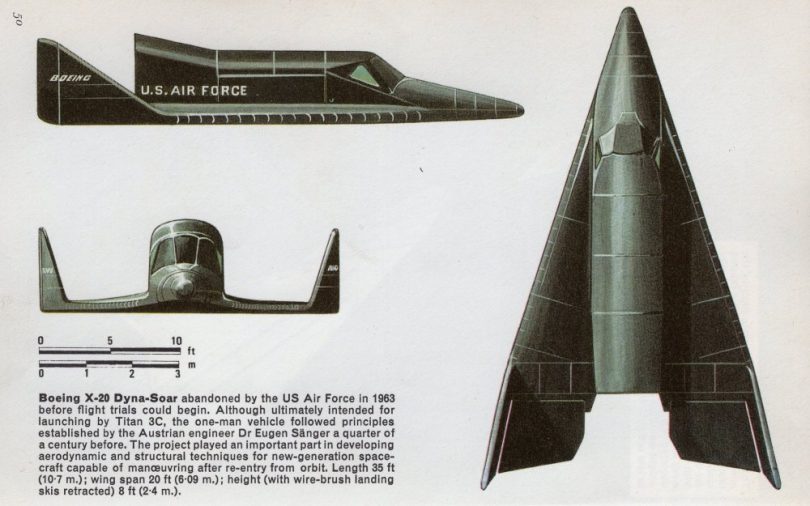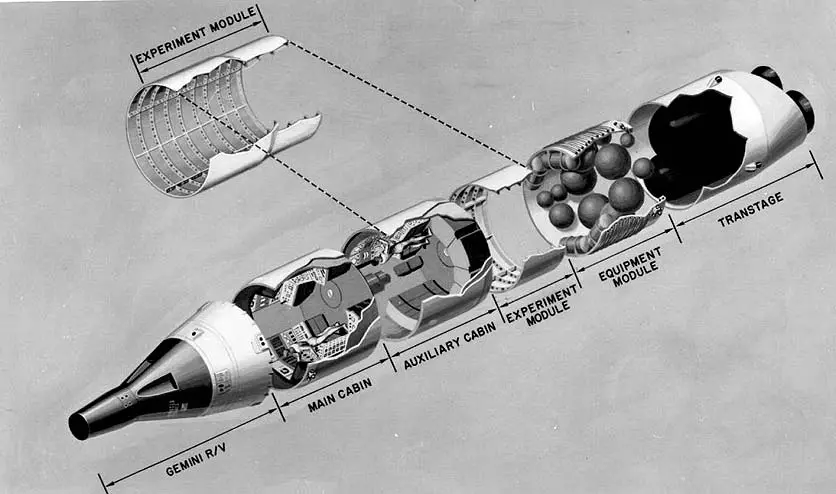The exhaustingly long space race between the USSR and the USA ran the risk every day of turning into a real military conflict in orbit. As they each developed their own secret programs to create the world’s first prototype orbital weapons, both superpowers tried to predict what a military confrontation in orbit would look like.
This story is about the mutual distrust of the two regimes, which led to the launch of weapons into space in contradiction of the universally recognized rules of international space law.
A miser pays twice: the X-20 and MOL
Ten years before the signing of the Outer Space Treaty, in 1957, entire analytical departments in the Pentagon were diligently wrinkling their foreheads, working to determine how space could contribute to national security and the promotion of American global interests.
Even then, it was obvious that jet aircraft, with proper modifications, were are capable of reaching orbital altitudes, maneuvering, and even performing manned reconnaissance missions. Finally, in October 1957, the US government approved a program for the creation of an orbital jet glider: the X-20 Dyna-Soar (Dynamic Soarer), developed by Boeing. The X-20 was intended to carry out missions for the US Air Force, in particular aerial reconnaissance, rescue missions, and satellite maintenance.
In addition, the X-20 was designed for the possibility of carrying out strikes, namely intercepting enemy satellites in orbit and conducting strategic and tactical bombardment. The glider was intended to be launched into orbit using an American Titan 3C ballistic missile modified for space launches.

The Americans were not the first to come up with orbital jet glider concept. The X-20 program was inspired by earlier designs by Nazi German engineers for a jet glider they called the Silbervogel (Silver Bird). The jet bomber was developed in the late 1930s. However, military setbacks kept the Nazis from allocating sufficient resources for the project, and favor was instead given to the development of the V-2, the modern first ballistic missile.
The German glider was designed to use the ignition of its engines to gain speed and achieve altitude, and then turn off its engines and go into loitering flight, relying on the aerodynamic properties of its fuselage.
The capabilities of the Silbervogel gliders seemed unthinkable in the 1940s. As conceived by the designer Eugen Senger, the aircraft could deliver a 4-ton bomb to New York, and then fly on across the American continent and the Pacific to an airfield of allied Japan.

In June 1959, Boeing won the tender to build the X-20. A year later, the company’s engineers presented a finished project for an aircraft with a delta wing whose frame was planned to be made of heavy-duty René 41 nickel-steel alloy. For better gliding through the layers of the atmosphere, the lower part of the Dyna-Soar hull was made from sheets of molybdenum, and the nose cone would be made of a carbon alloy (graphite with zirconium rods). The aircraft could reach Earth escape velocity (7.91 km/s). There were plans for three variants of the X-20 for the purposes of research, reconnaissance, and bombing – the Marks I, II, and III, respectively.
To increase the X-20’s payload capacity, it was to be flown by a single pilot. In the 1960s, seven NASA astronauts were selected for the Dyna-Soar program, including Neil Armstrong. However, he never got the opportunity to sit in the cockpit of a real Boeing X-20 – after many years of development, the project experienced serious problems with financing and, in the end, never managed to reach the launch pad.
In December 1963, the X-20 program was replaced by a project for a manned orbital station called the MOL (Manned Orbital Laboratory), or KH-10 (Keyhole 10). According to the plan, a rocket was supposed to launch the orbital station along with a Gemini return spacecraft attached, with two crew members on board. Upon reaching the orbit, the astronauts would be able to go to the orbital station through a gateway connecting it to Gemini. The KH-10 was equipped to stay in orbit for four weeks, but the modified Gemini B capsule was able to extend this period to 40 days.
The Pentagon understood that in order for the MOL to fly, they would need to provide the USSR with guarantees that the station would not make reconnaissance flights over Soviet territory. The compromise solution was as follows: the USSR would not protest against the launch of the MOL if the station was launched into an equatorial orbit with an angle of inclination of under 36°, which would leave Soviet territory out of view.

Source: USAF
As a civilian agency, NASA contributed in every possible way to the creation of MOL, but since purely scientific purposes could not fully justify the huge cost of the KH-10, the US Air Force was entrusted with overseeing the project. MOL was not planned to carry any kind of conventional weapons, although some military departments seriously discussed the prospects of using the station to eliminate or capture Soviet satellites.
With the help of the orbital station, the USAF intended to explore the possibility of conducting military operations in orbit, as well as to test its side-looking radar technology and encrypted communications system. The military was also interested in studying the ability of the human body to endure long-term space travel, as when the project was approved, the maximum time a person could stay in orbit was only five days.
So, on November 3, 1966, the first unmanned launch of a mock orbital station (made from a Titan-II fuel tank) was carried out using a Titan-IIIC rocket. The launch carried Gemini B spacecraft, a payload of two OV4-1T and OV4-1R communication satellites (for investigating methods for transmitting radio waves in the charged ionosphere), as well as an OV1-6 satellite designed to collect data on the environment in particular the radioactive background in near-Earth orbit.

Eight of eleven planned experiments were carried out during the station’s time in orbit. Alas, the lack of engines that could have helped MOL align its orbit led to the inevitable – it collapsed in the lower layers of the earth’s atmosphere on January 9, 1967.
When the arrival of a new US Secretary of Defense, the station project began to experience serious funding problems. The development of the MOL took 5.5 years and required $1.56 billion in government funding. However, in the end, after not being able to find a specific space mission, a new station was never launched. In 1969, the project was finally curtailed, as defense dollars began to be sucked up by the massive demands of the Vietnam War.
Echoes of X-20 could later be seen in subsequent models of the Boeing X-37 and X-40, which are still involved in space missions, as well, course, as in the space shuttles which America would use for decades as its main way to send people into orbit. Engineering solutions from the MOL would also be used on the Skylab station, which was launched in May 1973.
The “Tsar Cannon” strikes back: Project Diamond
The Soviet secret services, of course, “saw” that a conspiracy of cosmic proportions was brewing overseas against them. Seriously concerned about the US development of the MOL orbital station, the USSR approved a project for Almaz, the world’s first military orbital station, in October 1964, which was carried out by OKB-52, located in the city of Reutov.
As envisioned by the chief designer of the orbital manned station (OMS) Vladimir Chelomey, it would consist of three modules:
- A main module carrying the station’s command center, to which other modules could dock, expanding its area and functionality.
- A functional cargo block (FCB), which was intended to supply the station with provisions, oxygen, and other types of cargo.
- A return vehicle, which could make up to 10 flights to the station, performing crew rotation missions.
The station was initially supposed to be launched into orbit on a Proton heavy-class rocket, but the USSR would later decide to abandon the idea of launching the return vehicle and station together, and instead put them into orbit separately and dock them once up there.
Officially, the USSR insisted that the station under development (later called “Salyut”) would serve exclusively for scientific purposes and was not a military facility. After signing the OST in 1967, the Soviets tried desperately to hide the fact that they were violating its terms.
Meanwhile, Soviet design bureaus were thinking about how not only to equip the orbital station with a set of radar reconnaissance equipment, but also to protect it in case of a possible approach of a hostile spacecraft which aimed to capture it.
The level of paranoia in this matter reached such an extent that the Salyut-3 orbital station (OPS-2) was secretly equipped with a rapid-fire automated R-23M cannon (designated Shield-1), which was equipped to fire 14.5 mm rounds. The gun was capable of striking at a distance of up to 3 km and with a rate of fire from 1800 to 2000 rounds per minute.

Author: Anatoly Zak
The design of the Shield-1 automatic cannon was borrowed from the turret of the Soviet Tu-22 strategic bomber and modified to fire in the vacuum of space.
The triumph of Soviet militarism took place on January 24, 1975, when Salyut-3 fired about 20 shots, after first turning the cannon in the direction of a Soviet satellite which was serving as a target. The firing was carried out remotely due to the fear that the vibrations from the shots could harm the astronauts in the hermetically-sealed station complex.
The wpr;d would only learn of the weapon’s existence, and the fact that it had been used, after the collapse of the Soviet Union, when the documents of the Almaz program were officially declassified. There is no confirmed video evidence or documentation of the result of the firing test, since Salyut-3 was completely destroyed during re-entry into the atmosphere. However, bearing in mind the foreign policy pursued by the USSR, the story of the orbital “Tsar Cannon” (a famous giant cannon made by the Russian Empire on display near the Moscow Kremlin) does not at all seem like a myth.
In conclusion, it is worth noting that the situation with the Outer Space Treaty of 1967 clearly demonstrates how short-lived political promises (and documents signed to prove them) can be in an era of global conflict. The USSR, as well as the United States, always understood that the confrontation between the two superpowers would sooner or later end with the collapse of one of the regimes. For both sides, space would serve as another arena in which they would seek to demonstrate their own superiority.





